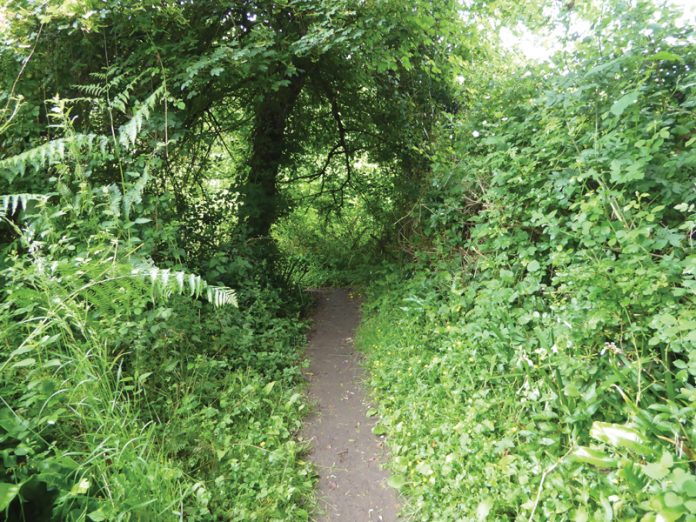Nearly 180 years ago, about three miles west of Lyme Regis, a huge chunk of the East Devon coast split off to form a plateau separated from the mainland by a deep, dry ravine. This was the largest movement of land ever experienced in this part of the country; it remodelled the coast and created a unique new environment. The plateau, now called Goat Island, and the ravine are still unique and when I walked there in late June, pink and purple orchids flowered across the grassy surface of the plateau whereas the ravine was populated by a tangled jungle of trees and other vegetation.
In the early 19th century, the land behind the cliffs in this part of East Devon was dominated by farming. Between the cliffs and the sea, there was an area of land, the undercliff, formed by subsidence that supported fertile market gardens and orchards with some pasture for animals. Cottages had also been built here for farm labourers who walked up and down the steep cliff path to the farmhouse a short distance inland. The latter part of 1839 had seen unprecedented rain and as Christmas approached, there had been ominous signs of instability in the cliffs with deep fissures opening on the cliff tops and settlement cracks appearing in cottages built on the undercliff.
One of the farm labourers who lived in the cottages with his family was William Critchard. At about 1am on Christmas Day 1839, Critchard and his wife returned to their cottage having been generously entertained along with other labourers’ families by their master at his farmhouse. Their Christmas Eve gathering had included the West Country custom of burning the ashen faggot (a large ash log) accompanied by the drinking of copious amounts of cider. On their way back to the cottage, the couple noticed that part of the cliff path had dropped about a foot since the morning and new cracks had appeared in the cottage walls. Still merry after their evening’s entertainment, they retired to bed unconcerned. At 4 am, however, they were awoken by a “wonderful crack” and by 5am they rose to find deep fissures appearing in the garden. They realised that something major was happening and set off up the cliff path, now almost impassable owing to subsidence, to spread the alarm.
Movement in the cliffs continued over the next 24 hours and as the day dawned on December 26th it revealed a landscape changed almost beyond recognition. Contemporary drawings show that a massive section of cliffs, about three-quarters of a mile long and estimated as 8 million tons of rock, had moved seawards by several hundred feet creating a dry ravine, the Great Chasm, in its wake. The plateau of land that had moved was bounded by cliffs 150 feet high and came to be called Goat Island. The ravine held a gothic landscape of lumps and bumps, peaks and troughs, vividly expressing the power of the convulsion that had occurred.
The cliffs in this part of Dorset and Devon are notoriously mobile, but the events of Christmas 1839 represented the greatest ever movement of land in the area. At the time there was much speculation as to the cause of the landslip: might it have been the result of an earthquake or a volcano, was it the work of rabbits, or could it have been a punishment from God? By chance, two of the most eminent geologists of the time, William Buckland and William Conybeare, were staying nearby and could interpret the events; Buckland’s wife Mary made invaluable drawings of the changed landscape. Buckland and Conybeare concluded that the excessive rain had saturated the permeable layers of chalk and greensand that constituted the upper part of the cliffs. Beneath these layers was an impermeable layer of clay and the chalk/greensand, saturated and very heavy, moved forward on the impermeable clay leading to the landslip.
The new landscape became a tourist attraction. Queen Victoria arrived on the Royal Yacht to view the scene and others took to paddle steamers to gaze in wonder while specially composed music, the Landslip Quadrille, was played. Bizarrely, fields of corn and turnips growing on cliff top land had moved intact with Goat Island and were ceremonially harvested the following August by local village maidens dressed as attendants of Ceres, the Roman Goddess of the Harvest.
But what of Goat Island nowadays? It’s only accessible on foot but the walk along the coast path is worth the effort. I set off from Axmouth on a misty but mild morning in late June to make the steep climb across the golf course and on to the cliff top. I followed narrow lanes with high banks and skirted cornfield edges to reach the coast path. Cliff edge scrub obscured the sea most of the time but occasional breaks revealed Beer Head lurking mysteriously in the mist.
About two miles into the walk, with my attention captured by the many flowers lining the path, I was jolted from my reverie as the path twisted and dropped down steeply into dense vegetation. It continued to descend with the occasional squirm to the right or left before bottoming out. About me now was a disorienting, tangled jungle of trees, shrubs and ferns with brambles and creepers dangling downwards to catch the unwary. Dampness hung in the air and only brief vestiges of light filtered through the canopy. This is the undercliff near the edge of the Great Chasm, no longer an open ravine but taken over by nature in the intervening 180 years.
Quite soon the track reared upwards again climbing steeply towards the light past a cushiony chalk hillside with a scattering of wildflowers. In time, the path levelled out to a long, lush grassy meadow sloping gently towards sheer cliffs above the undercliff and the sea; this is Goat Island. Woven within the grass were the frilly flowers of eyebright, many yellow dandelion-like flowers of catsear, patches of yellow rattle and wild thyme and two blue spikes of viper’s bugloss. It was, however, the orchids that surprised me with their number and variety: pyramidal orchids with their intensely pink, three-lobed petals overlapping like ornate roof tiles and common spotted orchids with their cylinders of lilac-pink flowers carrying magenta hieroglyphics. I searched for bee orchids and found only two spikes, each bearing several flowers. With their mauve propeller-like sepals and their large central petal complete with furry edges and yellow horseshoe patterns on a maroon background, these flowers are one of nature’s marvellous mimics said to resemble bumblebees. Butterflies, especially marbled whites completed the scene. Goat Island nowadays is a beautiful, unusual place, an oasis of calm where noise means bird song. It is also a managed landscape, a cooperation between nature and humans, as every year the grass is mown to encourage flowers and to prevent scrub taking back the land.
Goat Island is also a place of history and I stood there for some time, trying to imagine the scene 180 years ago when the land beneath my feet moved and the lives of the people living there were changed forever.
Philip Strange is Emeritus Professor of Pharmacology at the University of Reading. He writes about science and about nature with a particular focus on how science fits into society. His work may be read at http://philipstrange.wordpress.com/










